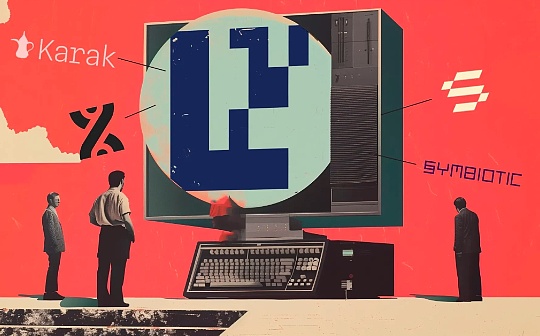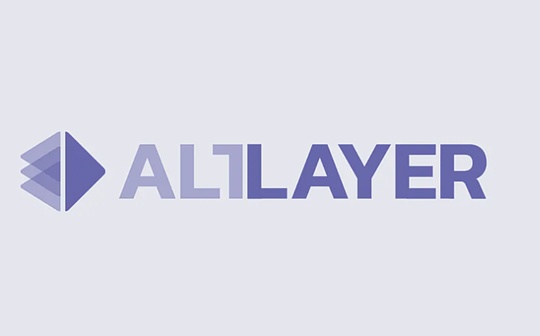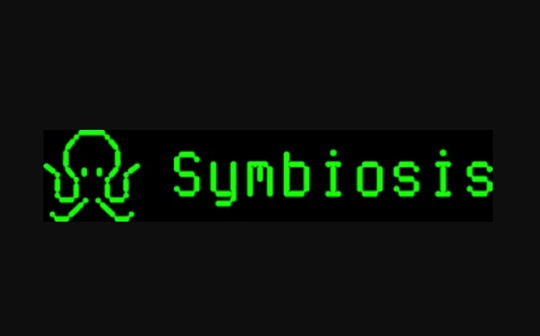ArkStream Capital: Thoughts on the Red-Pledge Agreement

Reprinted from jinse
01/02/2025·3MAuthor: Larry Sukernik & Myles O'NeilL Source: ArkStream Capital Translation: Shan Ouba, Golden Finance
“ If only you could see yourself in my eyes ” — from “Lost” by Dermot Kennedy
We spend a lot of time at Reverie looking at re-hypothecation protocols. This is an exciting area of investment for us because everything is still unclear (opportunities exist in ambiguous markets) and there are many projects underway (dozens of projects will be staked in the next 12 months field comes online).
As part of our research into rehypothecation, we have uncovered a few observations about how the rehypothecation market will develop over the next few years.
These are new things, so what is true today may not be true tomorrow. However, we still want to share some preliminary business dynamics observations about the rehypothecation market.
LRT as leverage point
Today, LRTs like Etherfi/Renzo occupy a strong position in the restaking supply chain: because they are close to both the supply side (stakers) and the demand side (AVS), they are in a privileged position on both sides of the transaction . If you think about it, this gives LRT the ability to (i) determine their rake rate, and (ii) influence the rake rate of the underlying market (eg, EigenLayer, Symbiotic). Given its strong position, you can expect the rehypothecation market to launch its own LRT to control the power of third-party LRT.
AVS/re-hypothecaters as leverage points
The best markets in the world share two characteristics: a fragmented supply side and a fragmented demand side. To develop an intuitive understanding of this, it helps to look at the opposite of concentration on either or both sides of the market.
Imagine a simple apple market, where the largest apple seller controls more than 50% of the apple supply. In this case, a large Apple seller could threaten to take his business elsewhere if the market operator decided to increase the market take rate from 5% to 10%.
Likewise, on the demand side, if the largest apple buyer controls more than 50% of apple demand, she can threaten to use another market (or buy directly from Apple suppliers) if the market operator increases the market take rate.
Returning to the re-pledge market, if the final market structure of the re- pledge market is concentrated on the AVS side (the top 10% of AVS account for more than 50% of the revenue) or the re-pledger end (the top 10% of the re- pledgers account for more than 50% of the revenue) deposits), then the natural consequence is that the market reduces its ability to extract commissions for itself (and should therefore demand lower valuations).
While there is not enough data to conduct a rigorous analysis, our intuition is that the power law rule will apply here: large AVS will constitute the majority of gross payout volume, and thus have negotiating power on the commission rate that the market ultimately wants to charge.
Fight for exclusive AVS
From the perspective of every rehypothecation market, every opportunity is worth pursuing to do something that competing rehypothecation markets cannot. As a re-hypothecation market, the easiest way to differentiate is to provide re-hypothecaters access to exclusive AVS – whether an in-house AVS like EigenDA or a third-party AVS through an exclusive partnership. Conceptually, this is similar to Sony developing PS5 exclusive games to drive hardware sales.
As a result of these dynamics, we expect the rehypothecation market to see the launch of more in-house AVS and/or exclusive agreements with third-party AVS. In short, the coming months will see a scramble for AVS.
AVS subsidy
AVS needs to pay for the services provided by the operator/re-stakeholder, which effectively means that AVS needs to be ready to pay in its native token, ETH/USDC, or possibly points/future airdrops. Having said that, since most AVS to date are early-stage startups without tokens, large balance sheets, or well-designed points programs/airdrops, the process of signing up operators/re-stakeholders has proven to be cumbersome (large Most EigenLayer partnerships are privately negotiated, custom contractual agreements). Simply put, this is a situation where a customer wants to purchase a service, may have the ability to pay, but currently does not have the money.
In order to drive business development, the re-hypothecation market will likely "prepay" startup fees to operators/re-hypothecaters, whether through their native tokens, balance sheet assets, or through the issuance of AVS that can be used to pay operators/re-hypothecaters "Cloud Points". In return for upfront funds, AVS is expected to commit airdrops/token allocations to the restaking market. Alternatively, the rehypothecation market could advance this money to AVS to convince it to choose you over the competing rehypothecation market.
In short, we expect the rehypothecation market to see intense competition over the next 12-24 months via subsidized AVS payouts. Similar to Uber/Lyft market dynamics, the restaking market with the most funds/tokens may end up being the winner.
White glove move-in service
Going from "I want to launch an AVS" to actually putting it into production is harder than it looks, especially for smaller teams that don't have much R&D capabilities. Examples that the team needs to address include how much security should be purchased, for how long, how much should be paid to the operator/re-stakeholder, what should be punished and how much should be punished.
Best practices will eventually emerge, but for now, the rehypothecation market will need to guide the AVS team through these issues (it is worth noting that EigenLayer does not yet have a payment or penalty mechanism).
To that end, we expect the winning rehypothecation market to be a bit like an enterprise sales business, providing customers with white-glove integration/service assistance to help them onboard their own products.
Graduate from the market
An interesting dynamic is that the most successful AVS may "graduate" from the restaking market to using their own tokens/revenue to purchase security.
Today, the appeal of restaking lies primarily with smaller projects that (i) don’t have the time/money/brand/relationships to recruit a validator set, and (ii) don’t have a high-value token to secure the network. But as projects grow, there is a possibility that their natural next step is to leave the restaking market and instead recruit their own set of validators and secure them with their own higher-value tokens.
Conceptually, this is similar to the dynamics of dating markets (e.g. Hinge, Tinder), where the most successful customers eventually leave the market. However, this kind of churn is bad news for marketplace operators because you lose a customer (which is one reason why dating marketplaces have lower valuations/multiples than those with repeat usage/low churn one).
One-stop encryption SaaS
To illustrate this observation, let's dive into some software history: Cloud providers like AWS give developers easy access to everything they need to launch an application or web service (e.g., hosting, storage, and compute). By significantly reducing the cost and time required to develop software, a new class of network services has emerged that are more specialized in service delivery. The combination of first-party cloud services and the vast array of "microservices" provided within the platform makes the cloud provider a one- stop shop for everything needed except core business logic.
Rehypothecation marketplaces like EigenLayer aim to create a similar set of microservices for Web3. Before EigenLayer, crypto microservices had the option of fully centralizing their offline components (and passing this risk on to their customers), or bearing the cost of launching a set of operators and economic staking to purchase security.
If rehypothecation markets work as expected, they may break this trade-off for microservices - you'll be able to prioritize security without sacrificing cost and speed to market.
Suppose you are developing a cheap, high-performance zk-rollup. If you go to a restaking marketplace like EigenLayer, you will have multiple choices of core services (such as DA and bridging) to facilitate onboarding. Through this process, you will see many other AVS microservices that you can integrate.
The more microservices a rehypothecation market offers, the better the customer experience will be - rather than evaluating the service functionality and security of dozens of independent vendors, applications will be able to purchase all the services they need from one rehypothecation market. Come because you serve X, stay because you serve Y and Z.
Some AVS create network effects (e.g. provisioning)
To date, use cases for restaking have mainly focused on exporting validators and economic stakes in Ethereum. But there is another class of “internal” focused restaking use cases that can actually add functionality to the Ethereum consensus without requiring changes to the protocol.
The idea is very simple - you give validators the option to make additional commitments around their proposed blocks in exchange for payment, and hold them accountable through slashing if they don't keep those commitments. We suspect that only a few pledge types will have enough demand to gain high levels of participation, but the amount of value flowing through these pledges has the potential to be significant.
Unlike the “external” re-staking use case, the effectiveness of such use cases is directly tied to validator participation. That is, even if you are willing to pay to join a block, it is not very useful if only 1 out of every 10 validators chooses to honor that commitment.
But if every validator chooses a given commitment, the guarantees behind it
will be equal to the guarantees provided by the Ethereum protocol itself (i.e.
valid blocks). Following this logic, we can expect strong network effects in
this category, as users of AVS benefit from every marginal validator that
chooses to enter the commitment market.
While this AVS category is still emerging, the logical distribution channel to
facilitate these use cases will be through Ethereum client sidecars and
plugins (such as Reth). Similar to the separation of proposers and builders,
proposers will likely outsource this work to dedicated actors in exchange for
a share of the revenue.
What's less clear is what form these AVS will take. While it is possible for one entity to create a universal marketplace for any type of commitment, we suspect that it is more likely that we see the emergence of a few players that specialize based on the source of demand (e.g., L2 for interoperability with L1) for DeFi driven needs.
Conclusion
For students of business strategy, The Business Dynamics of Recapturing Markets is a treasure trove of content worthy of in-depth study. As you can probably tell from the above, we had a lot of fun diving into these projects.




